David Suzuki's Blog, page 48
December 9, 2015
Accounting for nature makes cents
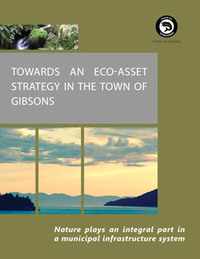
With help from the David Suzuki Foundation, Gibsons, B.C., has adopted an eco-asset strategy.
The small community of Gibsons on B.C.'s Sunshine Coast has become a leader in North America for its approach to managing and conserving nature. With the Foundation's help, the town now includes natural assets such as creeks, watersheds and beaches alongside capital assets such as roads and sewer pipes in its financial management approach. It has adopted a strategy that recognizes environmental assets can provide clear benefits over engineered infrastructure. The town is valuing nature's services such as cleaning the water and air, while reducing budgets that would have been spent on grey infrastructure replacements such as water-filtration plants.
The Foundation is partnering with the Town of Gibsons to build the economic model, including accounting tools accepted by Canadian Accounting Standards for tracking ecological assets, and helping with the town's plans for monitoring and maintenance.
Gibsons is finding that when nature is accounted for and valued alongside other municipal assets the town can better prepare for the effects of climate change. The approach, which uses natural capital tools, also supports efforts to become carbon-neutral, ensuring an easier transition to a low-carbon future. Nature's ability to manage rainwater, control floods and purify water is expected to reduce the municipality's risk and operating and maintenance costs. Unlike bridges and roads, nature doesn't depreciate if properly managed. Along with cost savings, the town's residents reap additional spiritual, cultural and recreational rewards when nature is conserved.
Given massive and growing municipal infrastructure deficits across the country and the mounting costs for climate-related events such as recent floods in Calgary and Toronto and this summer's wildfires in B.C., this approach couldn't be timelier for Canada's cities. The hope is that Gibsons' success will be replicated by larger municipalities across North America.
Hey! Want more DSF? Join David Suzuki on Facebook

December 8, 2015
Rock your holiday entertaining with tasty sustainable seafood treats

Drunken garlic prawns (Credit: Melody Fury of GourmetFury.com)
It's holiday time! What better treat than delicious sustainable seafood appetizers and meals you can also feel good about serving?
This month's focus is on spot prawns, Dungeness crab and oysters.
Spot prawns
Spot prawns (sushi name: amaebi) are the largest shrimp species found in Canada's West Coast waters. They have a reddish brown shell and distinctive white spots on their abdominal segments. Caught wild or by trap off B.C.'s coast, they're a SeaChoice "best choice".
Prawns are known for their sweet, succulent flavor and firm texture. They cook in just a couple of minutes and give amazing results with little effort. Spot prawns are available frozen year-round. Avoid buying prawns or shrimp that are not SeaChoice "green" or "yellow" options. Farmed shrimp from the tropics are associated with severe habitat destruction.
Try drunken garlic prawns by SeaChoice ambassador Melody Fury.
Dungeness crabs
SeaChoice lists Dungeness crabs as "yellow", or "some concerns". While their population is generally stable, concerns remain about high levels of fishing, though good fisheries management in B.C., Washington and California has led to stable catches over several decades. The crabs are wild-, pot- or trap-caught and don't involve a lot of bycatch. There is some concern over fisheries' interactions with endangered whale populations.
Savour delicious Dungeness crab cakes by Angela Tunner.
Oysters
Farmed oysters, found throughout the world's oceans, are an excellent SeaChoice "best choice" option. Oysters are farmed in natural intertidal or sub-tidal waters in rafts or floats, or fixed to the seabed. Farming oysters improves coastal conditions by converting nutrients and organic matter to biomass.
Yumm. Smoked (canned) oyster and bacon stuffing. Serve stuffing in mini bowls or cupcake foil for appetizers.
All the best for your holidays!</p
The David Suzuki Foundation sustainable seafood team
Hey! Want more DSF? Join David Suzuki on Facebook

Western Canadian provinces vying for "climate leader" status

Alberta hopes to reduce reliance on fossil fuels with its Climate Leadership Plan. (Credit: Jeff Wallace via Flickr)
Over the past few months, we've seen a flurry of activity from subnational governments regarding strategies to reduce carbon emissions and drive investment in renewable energy. Almost in unison, Canada's two westernmost provinces launched efforts to strengthen plans to tackle climate change -- B.C. with its Climate Action Plan 2.0 and Alberta with the Climate Leadership Plan.
Each effort has involved lengthy public consultations, and the David Suzuki Foundation has provided recommendations on how to achieve emissions reductions goals and solicited feedback from the public. On August 12, Foundation climate change policy analyst Kyle Aben hosted a public webinar to guide participants through the B.C. government's online consultation process, and on September 8 and 15 Aben attended closed-door meetings in Alberta with industry and government leaders to brainstorm a low carbon path for Canada's highest-emitting province.
These efforts have proved worthwhile. Alberta's town hall consultations were well-attended and the Foundation received positive feedback in both provinces.
The United Nations climate negotiations in Paris are fast approaching, and subnational governments are taking their roles in these talks seriously. Many experts believe that even if national governments fail to reach an agreement to limit global temperature rise to 2 C, the same goal (or at least significant progress) could be made by lower levels of government working together to cut emissions.
The David Suzuki Foundation will continue to be actively involved as B.C. and Alberta develop specific policies and other provinces follow their lead.
Hey! Want more DSF? Join David Suzuki on Facebook

Blue Dot movement keeps on rocking
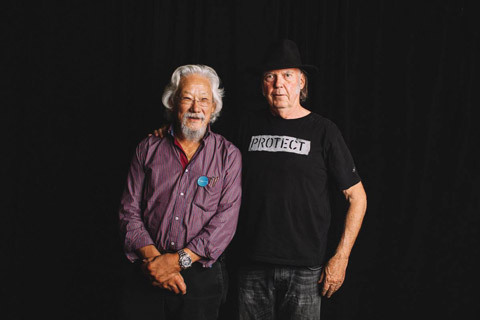
Neil Young recently donated $100,000 from a Vancouver concert to the Foundation's Blue Dot campaign.
The Blue Dot movement is on a roll. Thanks to our amazing volunteers and donors, more than 90 municipalities -- representing at least one in seven Canadians -- have passed environmental rights declarations.
Now the campaign is reaching the provincial level. In an unprecedented move, municipal leaders from throughout B.C. spoke passionately on behalf of a provincial right to a healthy environment at the September Union of B.C. Municipalities annual meeting. After a nail-biting vote, the UBCM passed a resolution calling on the B.C. government to enact an environmental bill of rights. Forty B.C. municipalities have already passed their own environmental rights declarations.
In October, Manitoba committed to developing environmental rights legislation. Premier Greg Selinger said he will introduce the bill before the provincial election set for April 19.
The Blue Dot movement also got a boost from rock icon Neil Young, who donated $100,000 from his Vancouver concert in October. Young helped launch the Blue Dot Tour a little over a year ago.
The support we've received from people across Canada -- volunteers, donors, artists, musicians and politicians -- has exceeded our wildest expectations and shows how important environmental protection is to Canadians. With the movement growing so quickly, we're
well on our way to having the right to a healthy environment included in the Canadian Charter of Rights and Freedoms.
More than half the world's nations offer constitutional guarantees for the right to live in a healthy environment, but Canada does not. Recognition of every Canadian's right to clean air, safe water, healthy food and diverse, abundant ecosystems would lead to stronger environmental laws, better enforcement of existing laws and improved environmental performance.
Hey! Want more DSF? Join David Suzuki on Facebook

Nurturing tomorrow's environmental leaders
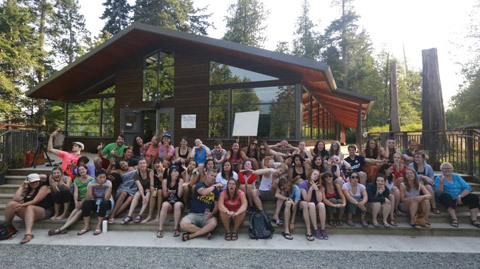
Camp Suzuki: Howe Sound gave 50 young participants an opportunity to learn about First Nations traditions and environmental stewardship.(Credit: Calder Cheverie)
Everyone loves summer camp. But what if it included fun activities and essential learning for tomorrow's environmental leaders? That's what happened for 50 young people, aged 17 to 35, from across British Columbia who attended Camp Suzuki: Howe Sound, held at Camp Fircom on Gambier Island this year. Participants from the Squamish Nation and local communities came together for a week to share experiences and learn about local ecosystems, traditional Squamish perspectives and the basics of community organizing and social change.
Camp Suzuki: Howe Sound gave participants the opportunity to grow and reflect while being welcomed into a community of like-minded, inspiring individuals. Squamish Nation leaders shared teachings about the traditional importance of Howe Sound stretching back thousands of years.
The experience's power to transform was captured by participants like Emily, who wrote: "It didn't matter if I had as much knowledge or experience as everyone else there, what I had was a desire to learn and a passion for the land I share with every other living creature, a land I simply borrow from future generations." Chris reflected on the importance of self-care in the world of activism: "What surprised me most about this camp was how focused it was on people, not the environment. I needed that, I needed to be reminded that I need to take care of myself before trying to take care of the world."
Following camp, participants become Howe Sound stewards through six-month volunteer placements with organizations working to protect the region. Camp Suzuki: Howe Sound was supported and run by the Foundation, the Squamish Nation and the United Church (Camp Fircom's owners).
Howe Sound is experiencing an astonishing marine rebirth as herring, salmon, porpoises and whales return after years of absence. We expect these young environmental leaders will play a big role in making sure the Sound's ecosystem remains healthy for generations to come.
Hey! Want more DSF? Join David Suzuki on Facebook

Canada must contribute to climate talks

World leaders will meet in Paris in December to hammer out a climate agreement. (Credit: Moyan Brenn via Flickr)
From Pope Francis's encyclical to Ontario's commitment to a cap-and-trade system and everything in between, 2015 has proven to be a groundbreaking year for worldwide climate action. The culmination of global efforts will undoubtedly be the United Nations climate summit in Paris in December. The David Suzuki Foundation has spent the past several months ramping up public engagement and government outreach in anticipation of a binding international agreement.
A poll released on September 28 by the Foundation in partnership with the Environics Institute revealed that Canadians' expectations for political leaders' involvement in a global deal to reduce carbon emissions are high and growing. Overall, 61 per cent of Canadians believe the country should sign an international agreement, and 66 per cent of those who support an agreement said they would be upset if Canada were not involved. Poll results also revealed a majority of Canadians (58 per cent) support a carbon tax to limit emissions domestically and an even greater majority (74 per cent) are confident that renewable energy can become the dominant form of power generation in their home province.
You can get involved by telling your government representatives to push for three Canada-focused outcomes in Paris:
A commitment to put a nationalprice on carbon pollution
A pledge from the Alberta government to start phasing out coal power immediately, with complete elimination within 10 to 15 years
Increased investment in renewable energy across the country
These outcomes require collaboration from all levels of government.
Hey! Want more DSF? Join David Suzuki on Facebook

December 7, 2015
The David Suzuki Foundation is encouraged by Quebec's $25 million climate pledge to vulnerable nations
Quebec's commitment to provide $25 million dollars over the next five years to vulnerable nations to help them mitigate and adapt to climate change represents a leap forward in the role provinces play in addressing this international issue. At a press conference today at the United National Climate Conference (COP21) in Paris, premier Phillipe Couillard announced that La Belle Province will provide $18 million in mitigation support and $8 million dollars in adaptation funding along with $1.5 million to engage youth on the issue of climate change.
"This is a major leap forward for a province that has a long history of climate leadership," said Ian Bruce, science and policy director for the David Suzuki Foundation. "Quebec's willingness to act on climate change internationally, both in their cap-and-trade market with California and now through this financial commitment, should be a signal to the rest of the world that some provinces are showing leadership on climate change."
Quebec's past actions, particularly its partnership with the State of California, have inspired other provinces to step up their own solutions. Ontario is in the process of creating its own cap-and-trade system that will become a part of the Quebec-California carbon market and earlier this week Manitoba became the third province to commit to a cap-and-trade carbon-pricing plan.
"The Canadian delegation's approach here at COP21 has sparked enthusiastic support from other nations," said Bruce. "It is amazing to see the province of Quebec join the federal government in providing critical funding to the nations that are at the greatest risk due to climate change."
The federal government pledged $2.65 billion in contributions to the United Nations Green Climate Fund last week, but is yet to announce it new targets for reducing carbon pollution domestically. So far at COP21 the Canadian government has pushed for the inclusion of human rights and indigenous knowledge in the Agreement being crafted.
Quebec has adopted the most ambitious target of any jurisdiction in North America with a goal of 37.5 per cent carbon emissions reductions below 1990 levels by 2030. However, they have yet to outline a plan for how this target will be reached. Quebec's transportation section (representing over 40 per cent of total emissions) is one area where massive reductions are both possible and necessary. Promoting
electric vehicles and public transportation infrastructure should be a central part of the plan the province produces.
30
For more information contact:
In Paris:
Steve Kux
David Suzuki Foundation
00-1-604-374-5095
skux@davidsuzuki.org
In Vancouver:
Theresa Beer
David Suzuki Foundation
778-847-3396
tbeer@davidsuzuki.org
In Montreal:
Manon Dubois
David Suzuki Foundation
514-679-0821
mdubois@davidsuzuki.org
Hey! Want more DSF? Join David Suzuki on Facebook

December 6, 2015
How to shop for V.A.L.U.E.

When we pay less, we also get less: less transparency, less accountability, and lower ethical standards and quality.
Fast fashion exploits the fact that people love a bargain to make us buy more for less. But cheap clothing and accessories are not made to last, low-priced items are more likely to contain lead (beware of bright and shiny handbags and wallets) and beading and sequins are a good indicator of child labour.
Kate Black, author of Magnifeco: your head-to-toe guide to ethical fashion and non-toxic beauty says that when we pay less, we also get less: less transparency, less accountability, and lower ethical standards and quality. Instead, she suggests we shop for V.A.L.U.E.:
V is for vintage or second-life: Does it already exist? Many resale items -- either in second-hand shops or online -- still have tags on them!
A is for artisan: Does it support craft, empower women or alleviate poverty? Ten Thousand Villages and Global Goods Partners offer a range of fair trade goods from around the world. Hundreds of thousands of people in the developing world, largely women, participate in the artisan sector.
L is for local: Does it serve my community? Support local businesses, markets and makers.
U is for upcycled: Does it save something from the landfill? Designers that create products from someone else's discards include Urban Lace, maker of unique jewelry pieces laser cut from inner tubes, and Freitag, a Swiss company that makes messenger bags out of truck tarps.
E is for ethical: Does it support human, environmental or animal rights? What's most important to you? Match brands with your values.
Fair trade is no longer strictly for bananas, coffee and chocolate. Two U.K.-based brands -- People Tree and Pachacuti -- are the first fashion companies to be certified fair trade by the World Fair Trade Organization. Oliberté boasts the first fair trade footwear factory and PACT Apparel makes organic basics like underwear.
Patagonia is probably the best known for working with environmentally friendly fibers (they only use organic cotton) but others are rising to the challenge, like EcoAlf and Groceries Apparel.
Want cruelty-free or vegan products? Matt and Nat is a Canadian, vegan bag brand and Vaute Couture and Brave Gentleman make womenswear and menswear, respectively.
What else would you like to know about fast OR eco-friendly fashion?
Comment on this blog to win Kate's book Magnifeco: Your Head-to-Toe Guide to Ethical Fashion and Non-toxic Beauty (draw date: January 7, 2016).
Sincerely,
Lindsay Coulter, a fellow Queen of Green
Hey! Want more DSF? Join David Suzuki on Facebook

December 3, 2015
UN climate talks offer hope for humanity
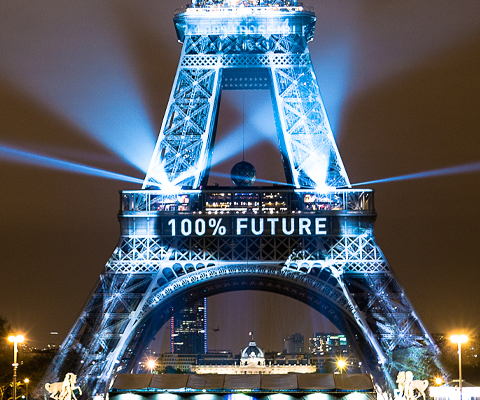
On the night before the COP21 summit, the Eiffel Tower radiates positive messages promoting climate change solutions. (Credit: Yann Caradec via Flickr)
With world leaders now meeting in Paris for the UN Climate Change Conference, we're seeing signs of hope for an agreement to limit the escalating effects of global warming. Canadians, especially, have reason to be optimistic about our country's role.
It hasn't always been this way. Governments have been formally discussing climate change since the 1992 Earth Summit in Rio de Janeiro, Brazil, and the first climate conference in Berlin, Germany, in 1995. Since then, we've been taking two steps forward and one step back -- not good enough when dealing with an accelerating crisis.
Canada signed the Kyoto Protocol in 1998, ratified it in 2002, did little to meet its targets, then withdrew in late 2011, the first and only nation to do so. The Climate Action Network selected our country for numerous Fossil of the Day, Fossil of the Year and Lifetime Unachievement Fossil awards for inaction on climate change and for obstructing international agreements.
But it appears leaders in Canada and globally are finally giving the issue the attention it deserves. Our government now has a minister of environment and climate change, and sent a delegation to Paris that includes a cabinet committee on environment, climate change and energy headed by Foreign Minister Stéphane Dion, as well as opposition party representatives and provincial leaders.
Alberta, which has long put fossil-fuel interests ahead of reducing greenhouse gas emissions, now has a comprehensive strategy to phase out coal power, promote renewable energy, put a price on carbon pollution and limit oilsands emissions. Ontario and Quebec have also moved to put a price on carbon emissions, joining California in a cap-and-trade system. Even Saskatchewan, not known for climate leadership, has committed to 50 per cent renewable energy by 2030.
Phasing out coal power and putting a price on carbon are effective ways to reduce dangerous CO2 emissions. Burning coal is the most polluting way to produce energy and creates the highest greenhouse gas emissions, and a well-designed carbon tax or cap-and-trade system has proven to cut emissions and fossil-fuel consumption without negatively affecting economies.
In its first five years, B.C.'s carbon tax, implemented in 2008, led to a 17.4 per cent drop in petroleum-fuel use, and greenhouse gas emissions went down while GDP remained strong. B.C. income tax rates remain the lowest in Canada.
Globally, things are also looking up. The Paris conference required the 196 participating countries to submit their own climate plans. Although those combined aren't enough to keep us below the 2 C increase in global average temperatures beyond pre-industrial levels that scientists say is necessary to avoid catastrophe, they do limit warming to a 2.7 C rise, which is at least a serious starting point. Current practices put us on track for a 5 C increase!
The Paris conference is also aiming for national climate plan reviews every five years to ensure targets are being met and to look at ways of improving them. And cities, local governments and businesses are being encouraged to do more, which has worked well in Canada.
Another important component of the Paris talks is to find ways to help developing nations improve prosperity while keeping emissions from rising. Developed countries have committed to raising $100 billion a year by 2020 to help developing nations though the Green Climate Fund, World Bank, government contributions and other mechanisms.
But government commitments only raise hopes so far. The other good sign is the rapid development of renewable energy technologies like wind, solar and geothermal. Coupled with energy conservation, renewables are critical to confronting the climate crisis.
A recent report from Stanford University and the International Renewable Energy Agency found it's technically feasible and economically viable for the world to shift to sustainable energy by 2030, and lays out a plan for 139 countries to reach that goal. Many jurisdictions are already getting a lot of their energy from renewable sources.
With clean energy production and grid technology improving and costs coming down, there's no excuse to continue rapidly burning diminishing supplies of fossil fuels. As leaders meet in Paris, citizens march in the streets and innovators develop solutions, we have more reason than ever to be hopeful for the future of our place on this small, blue planet.
Hey! Want more DSF? Join David Suzuki on Facebook

December 2, 2015
Remembering Maurice Strong
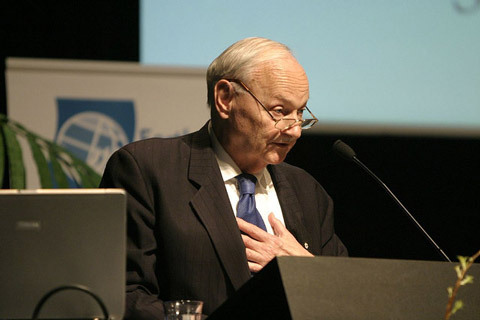
(Credit: Richard Chu via Flickr)
Internationally recognized environmentalist Maurice Strong, who served as the founding executive director of the United Nations Environment Programme, died on November 27, 2015 at the age of 86.
Born in Oak Lake, Manitoba, Strong grew up during the Depression and later held a number of posts with the UN, including secretary general of the Stockholm Conference on the Human Environment in 1972 and secretary general of the 1992 Earth Summit in Rio de Janeiro, which resulted in the United Nations Framework Convention on Climate Change and the United Nations Convention on Biological Diversity.
"Maurice was a giant in the history of the modern environmental movement and a friend. His passing deserves our attention and respect," wrote Tara Cullis, David Suzuki Foundation president.
Strong received many awards of distinction, including the Order of Canada and more than 50 honorary doctorates.
In recent years, Strong continued to be active, attending Rio+20 the United Nations Conference on Sustainable Development in 2012, and co-authoring Only One Earth: the Long Road via Rio to Sustainable Development with Felix Dodds and Michael Strauss.
Catherine McKenna, Canada's minister of environment and climate change, described Strong as "a great Canadian", tweeting "Let's honour his life & legacy w/an ambitious (agreement) & concrete actions" in Paris.
Hey! Want more DSF? Join David Suzuki on Facebook

David Suzuki's Blog
- David Suzuki's profile
- 247 followers



